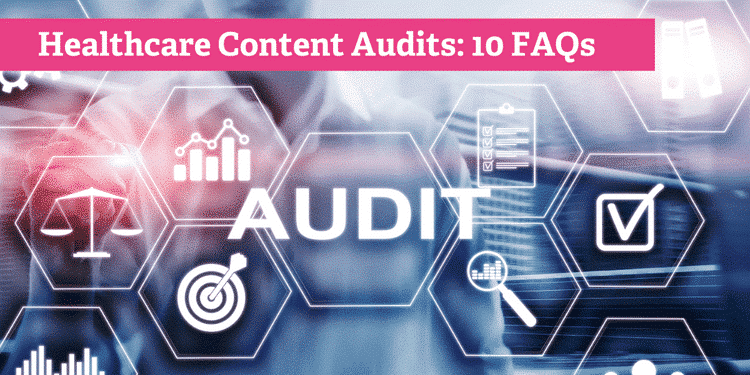
This article is the second in our 3-part series on tips for interviewing healthcare stakeholders and using the information to create engaging, robust content. Read part 1: 3 Steps to Prep for Interviewing a Healthcare Stakeholder.
It’s exciting to have the opportunity to interview a stakeholder who has the information you need to pull together awesome content. But if you’re talking to a busy doctor or nurse, you may only have an hour (or less) of their time. How can you make the most of it? Follow these 6 steps for running an effective interview.
Step 1: Do Some Recon
In our first post, we talked about the importance of understanding the subject matter before making your list of questions. But it’s also important to understand the stakeholder. Talk to the client to find out if there’s anything you should know about the person you’re interviewing.
For instance, it’s helpful to know if the doctor isn’t thrilled about being part of the project, if English is the expert’s second language or if the person you’re speaking to has hearing difficulties. All of these details can impact the way you communicate with them and the information they can provide. Being prepared can help you get the most out of your time with them.
Step 2: Send a Reminder
Your stakeholder’s expertise is a precious commodity, which is why it’s common to have multiple parties vying for their time – regardless of what’s on their schedule. Your chances of connecting will increase significantly if you send a reminder the day before.
A simple email stating the time and purpose of the call along with the logistics (usually your conference line number) keeps the interview top of mind. This way, if your stakeholder bumps into someone who wants to chat 5 minutes before your interview, they are more likely to finish up in time to join you on the conference line.
Step 3: Offer a Brief Introduction and Background
Take a few minutes to build rapport and establish a context before diving into your questions. Doing so puts your stakeholder at ease, which allows the conversation to flow naturally.
- Introduce yourself: State your name and who you are, talk about the project you’ll be discussing, and let them know you’re excited to talk to them.
- Explain the purpose of the interview: Confirm which topic(s) you’d like to discuss. For example, if you’re talking to the neuroscience division chief, and your project is focused on epilepsy, mention this up front. Briefly describe the deliverable, timing and any other pertinent details.
- Give a rundown of how the interview will flow: Confirm how long the interview will take and how you expect it to run. You may say, “We’ve set aside an hour for this interview. Does that still work for you?” And then, “I’d like to ask you questions and give you some time at the end to add anything we may have missed. Of course, feel free to interrupt me if there are extra details that come to mind as we’re going through the questions.”
- Ask if they have any questions: Shoring up immediate concerns can be a huge time-saver. For example, confirming the audience is consumers and not clinicians can help you avoid backtracking once you get started.
Step 4: Record the Interview
Always ask the stakeholder if you can record the call before you begin. Most interview subjects are open to this, especially if you explain it’s solely for note-taking purposes.
Recording the interview allows you to stay engaged in the conversation without obsessively jotting down answers or worrying that you missed a key point.
Step 5: Have a Plan, But Pivot as Needed
Since you’re now well-versed on the topic from doing excellent research (see part 1 of this series), you’re the best judge of what questions to ask.
Here are some pointers for getting the most out of your game plan:
- Start with an open-ended question: For example, “Can you give me an overview of your program?” The response often reveals which aspects of the program they feel are important to emphasize. Chances are, you’re primed to ask more about these very topics. And if the stakeholder mentions something that’s not on your list, such as a new treatment technology, be sure to probe for details.
- Don’t stress if your open-ended question is a flop: You may get dead air. Not a problem! Some stakeholders are more comfortable with focused questions. Aren’t you glad you’ve prepared a list? Dive right into it. And take heart: Sometimes, a stakeholder needs a few questions to “warm up,” and then the information gravy train starts picking up speed. In no time, they’ll be offering up all kinds of helpful nuggets.
- Get those essential questions in first: This approach means the conversation may jump around a lot (for example, from outcomes to diagnostic tests to the stakeholder’s level of training). So give the stakeholder a heads up by saying, “Let’s move on to a different topic,” and off you go.
Step 5: Give Them the Floor
When you’re done with your questions, hand the reins over to your stakeholder. By now, they’re comfortable talking to you, and they have a better idea of what information you need.
Ask something like, “Is there anything else you’d like patients to know about your program?” And without fail, one of these things happens. The stakeholder will:
- Tell you something new: They may mention things that aren’t public knowledge, such as an innovative treatment they just started offering. Or, they may shed light on a current offering, like a weekend clinic that has no web real estate but could use a shout-out.
- Emphasize a point: During the interview, you were preparing a mental list of the program’s differentiators. Suddenly, toward the end of the hour, the stakeholder emphasizes something you initially thought wasn’t a big deal. If they’re mentioning it in the wrap-up, it IS a big deal. Make sure you have enough information so that the content writing is a breeze. You may need to ask for more details to make that happen.
- Provide a recap: You’ve just spent the better portion of an hour wrapping your head around the nitty-gritty details, so a quick rundown of key points is extremely helpful. This information comes in handy when you’re writing high-level messaging, such as landing page content.
- Say an interviewer’s favorite 6 words: “Nope, I think we’ve covered it.” You’ve checked the final box of making sure the stakeholder feels heard. Now you can pat yourself on the back for a job well done.
Step 6: Wrap Things Up
After the stakeholder’s final words, add a few of your own by letting them know what comes next. You might want to explain how long the writing process will take and if they’ll have the opportunity to review draft content for medical fact checking. Hint: Having the expert review the content is always a good idea.
And do yourself a favor: Leave the door open by asking if you can email them if you think of any additional questions. After you’ve said your goodbyes, you may want to jot down some of the key takeaways or concerns the stakeholder raised so you can hit the ground running when it’s time to start writing.
Check back soon for the final installment in this series, where you’ll learn why interviewing stakeholders is the secret sauce to compelling content.
Read More Musings From Our Content Creation Squad:
- Chocolate and Community: Content Lessons Courtesy of Willy Wonka
- What Is Conversational Writing? And How to Get It in Your Organization
- This Is a Trick Blog Post
- 8 Proven Ways to Help You Stand Out on Twitter




